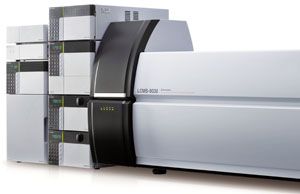LCMS-8030
Shimadzu's LCMS-8030 features the most innovative technology found in a commercial tandem quadrupole mass analyzer. Combined with the class-leading Nexera UHPLC, both systems facilitate seamless LC/MS/MS analyses in a high-performance, high-speed flow, steadily and reliably.

Shimadzu's LCMS-8030 features the most innovative technology found in a commercial tandem quadrupole mass analyzer. Combined with the class-leading Nexera UHPLC, both systems facilitate seamless LC/MS/MS analyses in a high-performance, high-speed flow, steadily and reliably.
The LCMS 8030 instrument features innovative highlights such as an ultrafast pulse counting system, a high speed UF sweeperTM collision cell and a novel RF power supply achieving complete stability within microseconds. These innovations enable this tandem quadrupole mass analyzer to provide the fastest measurements possible, including a scan speed of up to 15,000 u/sec without compromising resolution, sensitivity or mass range. It supports a 15 ms polarity switching time and gives reproducible MRM results with just one millisecond of dwell time, resulting in up to 500 MRM measurements per second.
With the current trend towards higher pressure HPLC and faster operating speeds for greater throughput, the LCMS-8030 is the ideal detector for keeping up with ever-faster chromatographic peaks. Very narrow widths of UHPLC peaks are now easily tamed by the LCMS-8030.
For further details please visit www.triplequad.com or ref="http://www.shimadzu.eu">www.shimadzu.eu
Polysorbate Quantification and Degradation Analysis via LC and Charged Aerosol Detection
April 9th 2025Scientists from ThermoFisher Scientific published a review article in the Journal of Chromatography A that provided an overview of HPLC analysis using charged aerosol detection can help with polysorbate quantification.
Analyzing Vitamin K1 Levels in Vegetables Eaten by Warfarin Patients Using HPLC UV–vis
April 9th 2025Research conducted by the Universitas Padjadjaran (Sumedang, Indonesia) focused on the measurement of vitamin K1 in various vegetables (specifically lettuce, cabbage, napa cabbage, and spinach) that were ingested by patients using warfarin. High performance liquid chromatography (HPLC) equipped with an ultraviolet detector set at 245 nm was used as the analytical technique.
Removing Double-Stranded RNA Impurities Using Chromatography
April 8th 2025Researchers from Agency for Science, Technology and Research in Singapore recently published a review article exploring how chromatography can be used to remove double-stranded RNA impurities during mRNA therapeutics production.





